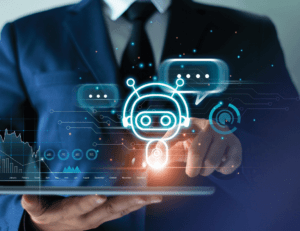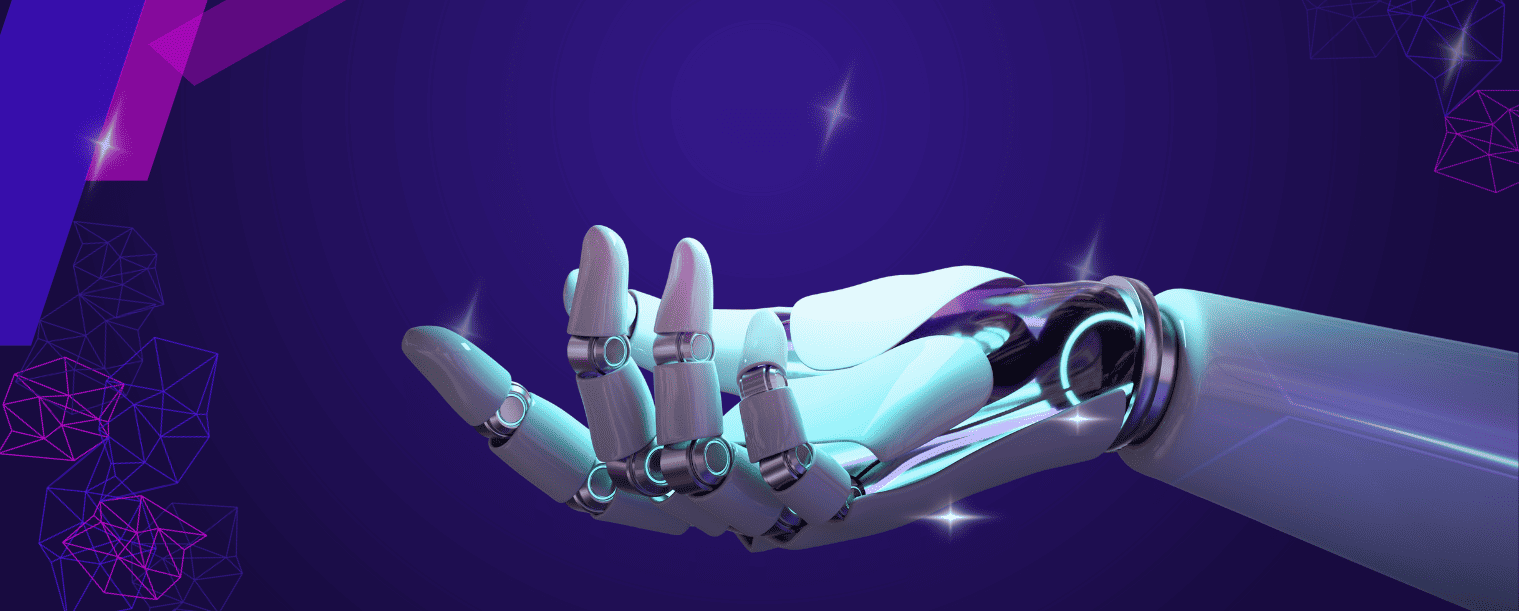Predictive Artificial Intelligence (AI) have been a scientific and academic discipline since the 1950s, but it has gained massive traction in recent years. There is no need to mention that AI research, real-world applications and investment are exploding right now.
It is estimated that by 2030 the global artificial intelligence market will have grown from $136.6 billion in 2022 to $1,811.8 billion with a compound annual growth rate of 38.1%. In addition to improving business results, AI applications offer the potential to enhance and enrich the human experience as a whole.
This article explores all the major industries that have reaped significant benefits from AI and are expected to grow significantly in the future.
First, let’s talk briefly about Preditive AI.
What is Predictive AI?
Predictive AI is a rapidly developing technology based on machine learning. It mainly refers to using computer systems to perform functions normally performed by human beings, such as natural language interpretation, speech recognition, and decision-making.
There are various AI models that are trained using vast volumes of data and have the ability to provide solutions to specific problems.

The AI revolution is making a tremendous difference to how businesses function and provide value to their customers, as it incorporates digital technology into all business domains.
Some facts and figures that you must know regarding predictive AI:
- It is estimated that AI will be used in 95% of customer interactions by 2025, according to Servion Global Solutions.
- Gartner reports that 37% of organizations use AI. Over the past four years, AI has been used by 270% of enterprises.
- By 2025, Statista estimates that the Artificial Intelligence (AI) software market will generate 126 billion dollars in revenue

How Does Predictive AI Works?
AI technology now allows computers to make judgments based on data. The process involves identifying patterns in data, creating algorithms and models, and growing through experience.
The two core pillars of artificial intelligence are deep learning and machine learning. In machine learning, algorithms learn from data and make decisions based on those predictions.
These techniques can either be supervised or unsupervised. An unsupervised algorithm is trained using unlabelled data, whereas a supervised algorithm is trained using labelled data.
The use of artificial neural networks is common in deep learning and machine learning. Because they are modelled like human brains, these networks are able to learn from a wide range of data. Deep understanding is especially helpful when it comes to speech and picture recognition.
Here’s a simplified breakdown of how predictive AI works:
Data Collection and Preprocessing:
Data collection is the first step in the process. In some cases, this data can be historical information, while in other cases, it may be current data, or a combination of both.
For analysis, raw data often needs to be cleaned and prepared. As part of preprocessing, missing values, outliers, and data formatting is done in a way to make it understandable for algorithm.
Feature Selection:
An attribute or variable in a dataset is called a feature. Algorithms identify which features are most relevant to prediction tasks and focus on them. Taking this step improves the efficiency and accuracy of the model.
Training the Model:
A training phase is used by the algorithm to learn the relationship between the input features and the desired outcome (prediction). During training, the model adjusts its internal parameters to minimize the difference between what it predicts and what actually happens.
Testing and Validation:
To verify that the trained model generalizes beyond the training set, it is then tested on new, unseen data. Validation helps assess the model’s performance and identify any overfitting (when the model is too specific to the training data and performs poorly on new data).
Prediction:
Once the model is trained and validated, it can make predictions on new, unseen data. The input data is fed into the model, and it generates predictions based on the patterns it has learned during training.

Continuous Learning:
This is an optional optional which is applied to predictive AI models in some cases. They are designed in a way that they can continuous learn. With new data coming in, they can adapt and improve. In dynamic environments, continual learning is essential.
Feedback Loop Model Enhancement:
In applications like recommender systems, user feedback on predictions can be used to refine and enhance the model. For example, if a user rates a recommended product, the model can use this feedback to improve future recommendations.
How is Predictive AI Shaping Every Industry?
Predictive AI has been playing an important role in almost every industry by providing solutions and opportunities that were not possible before. Whether it’s retail, manufacturing, or health care, it improves efficiency, quality, and innovation in a variety of industries.
Let’s have a look at its applications in some of the major industries:
Retail and E-Commerce:
In retail and e-commerce, AI’s application is most obvious and observable, facilitating the ability of the majority of customers to see its impact.
In order to stay competitive, retail organizations always look for ways to find patterns in consumer behaviour so that they can adjust their business strategy accordingly.

The use of artificial intelligence has enabled these organizations to better meet the evolving needs and expectations of their customers. To determine which products you are more likely to purchase, Amazon uses complex AI algorithms to recommend products to you.
In addition to enhancing the customer experience, AI applications are becoming increasingly popular. AI-powered chatbots are commonly available on e-commerce websites and can provide instant answers to a variety of customer questions.
Here are some amazing facts regarding the use of AI-powered chatbots that you must know:
- A chatbot can handle 70% of conversations.
- Businesses can save up to 2.5 billion hours by using chatbots to manage 17 interactions per day on average.
- The use of chatbots in healthcare and financial services will increase to 90% by 2023.
- Having grown 24.9% in the last year, Chatbots are the fastest-growing medium for brand communication.

Logistics and Transportation:
Predictive AI is also shaping logistics and transportation greatly. Machine learning is already transforming supply chain management, making it seamless. Warehouses often use AI-powered robots to sort and package products.
Further, AI algorithms are also increasingly being used for last-mile delivery and to find the quickest routes for shipments. The next big thing in transportation will undoubtedly be self-driving vehicles.

Research and trials are already underway for such vehicles in many countries. It is predicted that in the future, self-driving technology will allow us to drive more safely on roads thanks to AI-based self-driving. There are a number of companies leading this innovation, including Volvo, Tesla, Volkswagen, and Uber.
In addition, AI algorithms are being developed for maximizing the scheduling and routing of public transportation as well as managing traffic lights.
Agriculture:
Agriculture is becoming more sustainable and productive thanks to artificial intelligence. Here are some ways in which AI makes the agriculture industry more efficient than ever before:
Monitoring crops:
Image analysis using artificial intelligence can help identify pests, diseases, and nutritional deficiencies in crops. Farmers can use this to increase the quality of their crops and protect them proactively.
These implementations can further help reduce the need for chemical inputs, which can have a negative impact on the environment. Compared to manual inspections, AI-based image analysis also gives more accurate results in real time.

Autonomous farming:
Planting, spraying, and harvesting no longer require so much time and hard work. Thanks to AI-powered robots and drones that can perform all these tasks without human intervention.
This can help reduce labour costs, increase efficiency, and improve safety. These technologies will minimize the use of chemical pesticides and fertilizers, ultimately resulting in lower environmental impacts.
Precision farming:
The use of AI algorithms can provide insights into weather patterns, soil health, and crop growth by analyzing data from sensors, drones, and satellites. As a result, farmers can optimize their inputs, reduce waste, and increase yields.
Predictive AI algorithms also help farmers identify areas where crops are underperforming and predict the best time for planting and harvesting.
This data can be used to:
- Adjust planting and irrigation schedules.
- Minimize the use of fertilizers.
- Optimize the use of water and other resources.
In the agriculture space, a firm named Sentient is leveraging AI to analyze the effects of variables such as UV light, salinity, heat, and water on basil. Armed with the data, they are developing methods to raise the perfect crops.
AI applications have also been introduced into the farming sector, where we have seen a surge in the use of intelligent tractors and intelligent plucking machines.
Food Tech:
There are numerous applications of AI in the food industry. The role of AI in food preparation and serving has come so far that there is no need to involve humans at all.
Several food companies have developed robotic food preparation machines that mimic human chefs. One such example is Hi Arya (a food tech company), which developed a robotic tea maker using AI and IoT. Users can design their own recipes using the web interface, mobile app, and smart tea maker.
They can direct the robot to prepare tea according to their preferences. Once a user places their order, the machine begins preparing their tea, and they are able to watch as it is being prepared.
Examples of Food Tech Industries Using AI
The industrial food processing sector is also incorporating AI development into its operations. Several food manufacturers, such as Campbell Soup Co., are incorporating AI into their product development processes.
Campbell is tracking data to figure out what its customers want next, and through automated evaluation of sensory analysis, it has introduced new products like the Chunky Ghost Pepper Chicken Noodle Soup.
Campbell used artificial intelligence to determine that modern consumers crave spice. Considering this information, the soup giant launched the aforementioned flavour after successfully launching Spicy Steak and Potato, Spicy Chicken Noodle, Spicy Sirloin Burger, and Sausage Gumbo.
Another company, Tomra Systems ASA, is using AI-based equipment for sorting commodities such as potato and beef items, including french fries, potato peels, and diced and ground meats.
Tomra’s food processors automate challenges related to food analysis, such as measuring the colour, size, and shape of french fries or analyzing fat content in meat/milk.
Education:
Using AI in the education industry has completely transformed the way we learn, bringing a variety of benefits.
There are a number of possible use cases, such as:
Virtual assistants: An AI-powered virtual assistant can assist students in answering questions, providing educational resources, and performing administrative tasks.
Intelligent tutoring: Students can benefit from tutoring systems powered by artificial intelligence by receiving personalized guidance, feedback, and assistance.
Adaptive assessments: Artificial intelligence can make assessments more effective based on student understanding, providing targeted feedback and recommendations.

Learning analytics: It is possible to analyze student performance data to discover patterns, trends, and areas where students need to improve with the help of predictive AI.
Personalized learning: With the use of AI students can create personalized learning paths based on their individual needs.
Automated grading: With AI algorithms, educators can automatically grade quizzes, exams, and assignments, saving time while providing students with timely feedback.
Healthcare:
AI is improving all types of processes in healthcare, including back-office functions and patient care.
Statista estimates that the artificial intelligence (AI) healthcare market will be worth $187 billion by 2030.
With such a massive increase, we will continue to see significant changes in how hospitals, healthcare providers, pharmaceutical and biotechnology companies operate.
Artificial intelligence (AI) has revolutionized healthcare by reshaping diagnoses, treatments, and patient monitoring. With this technology, healthcare research and outcomes are dramatically improved by producing more accurate diagnoses and enabling more personalized care.
Medical professionals can identify disease markers and trends with AI’s ability to analyze vast amounts of clinical documentation quickly. There is a wide range of applications for AI in healthcare, ranging from scanning radiological images to predicting outcomes.
Additionally, it is used in robotic surgery. medical imaging, drug discovery, and medication management.

Here are some examples of AI technologies being used in healthcare recently:
- IBM Watson (an AI tool) which can analyze structured and unstructured data, such as medical records, to determine the best treatment plan and identify potential treatments. The IBM Watson system functions similarly to a human physician.
- NuMedii’s Artificial Intelligence for Drug Discovery (AIDD) platform combines big data analytics and artificial intelligence to detect the relationship between diseases and drugs.
Some other ways in which AI is helping the healthcare industry include:
Virtual nursing assistants
A study found that 64% of patients are comfortable with the use of artificial intelligence for accessing nursing support at any time.

Virtual nurse assistants powered by artificial intelligence can answer questions about medications, forward reports to doctors or surgeons, and schedule physician visits. They are AI-powered chatbots, apps, or other interfaces.
Routine tasks like these free up clinical staff from routine work, so they can focus on what matters most to patients, which is human judgment and interaction.
Fraud prevention:
Healthcare fraud costs consumers $380 billion per year and increases their medical premiums and out-of-pocket expenses.
Using artificial intelligence can help identify unusual or suspicious patterns in insurance claims, such as billing for costly services or procedures that were not performed.
Aside from that, it helps with unbundling (billing separately for each step of a procedure) and performing unnecessary tests for insurance purposes.
Manufacturing:
Manufacturing is undoubtedly one of the leading industries in AI adoption and application. From workforce planning to product design, AI is used throughout the manufacturing process to improve efficiency, employee safety and product quality.
Artificial neural networks and machine learning are used in factories to predict the malfunction of critical industrial equipment.
In addition, it helps the management prevent unplanned downtime and restore the equipment in a timely manner. In the production process, robots play an integral role. A majority of industrial robots are stationary, yet they are in danger of crashing into nearby objects because they are stationary.
By using AI in robotics, we can create collaborative robots that can work with humans and take their instructions. Besides this, AI algorithms are used in quality control to detect production faults that can affect product quality.
Real Estate:
AI is paving the way for success in many industries, and the real estate industry is no exception. Real estate has entered a new era of business transformation.
As AI redefines the way we buy, sell, and invest in properties, it is catalyzing a paradigm shift in the landscape of property ownership and rental living.
There is a growing convergence between agents and brokers as they become more efficient and effective, and consumers are feeling more empowered than ever before.
By using AI-powered bots, brokers and agents can better serve the needs of potential buyers, renters, and sellers.

The real estate industry can benefit from artificial intelligence in the following ways.
- It is possible to automate the management and processing of real estate documents using artificial intelligence, including lease mortgages, agreements, and title deeds.
- The use of artificial intelligence can help real estate professionals predict property values, trends, and investment opportunities based on market conditions, property prices, and other factors.
- AI-based chatbots are available 24/7 and can answer visitors’ questions even during odd hours.
- In the real estate market, predictive modeling is used to predict rental income, property prices, and other factors.
- Furthermore, thermostats and security systems can be integrated with AI to enhance energy efficiency and security in smart homes.
Legal:
Artificial intelligence (AI) is changing the legal industry by enhancing the accuracy, productivity, and efficiency, with a wide range of applications.
Document automation:
Up to 23% of a lawyer’s daily tasks can be automated with artificial intelligence and automation. Often, these activities are routine, paperwork-based tasks that divert legal professionals’ attention from the strategic demands of their cases.
AI-driven document automation tools can streamline legal document generation, reduce errors, and save time.
Contract Analysis:
Lawyers analyze contracts in bulk and give clients comments and redlines. Automated contract analysis can reduce manual effort and increase efficiency by reviewing and extracting key clauses.
E-discovery:
As a result of the capabilities of artificial intelligence algorithms, lawyers can use e-discovery in legal proceedings to analyze and categorize large amounts of e-mails and electronic documents.
Legal research:
A large amount of legal texts, precedents, and case law can be analyzed using artificial intelligence to gain valuable insights.
Chatbots and virtual assistants:
It has been shown that artificial intelligence can be used to develop chatbots and virtual assistants that respond instantly to common legal queries, assist with legal procedures, and improve client communication and engagement.
Finance:
Due to the emergence of artificial intelligence applications, the banking and financial services industry is experiencing a massive transformation.
The use cases of AI in this space are numerous. The use of intelligent software robots is replacing human agents in many loan processing scenarios in a fraction of a second.
In a similar way, robo-advisors can filter through large amounts of data in seconds to recommend the best investment strategies for customers. As well as analyzing your social media activities, emails, and other personal data, these robo-advisors can identify sectors and companies that match your needs and long-term goals.
Fraud detection is another important application of AI in finance. By analyzing a variety of data points, Mastercard, for example, detects fraudulent transactions with AI-based decision intelligence.
AI-based chatbots are also being deployed in the Insurance sector to improve the customer experience and create insurance plans and products based on customer data. Furthermore, AI-based software has greatly reduced the time it takes to process claims, which has been beneficial to insurance companies as well as customers.
Impact of AI on Employment in Finance:
Financial institutions are currently investing heavily in AI technologies as they realize their potential to generate a lot of value for their businesses. It is estimated that AI can generate over $250 billion in value for financial institutions by applying it to their processes.
According to a survey, 75% of respondents at banks with assets over $100 billion are implementing AI. Accordingly, companies are seeking employees with experience in fields such as data analysis and programming.
Media and Entertainment:
There are numerous applications and use cases for artificial intelligence in the media industry. The media industry can benefit from it in the following ways:
Video and image analysis:
Artificial intelligence is used for video and image analysis, such as object recognition, sentiment analysis, and facial recognition, which helps content be organized and targeted better.
Fraud detection:
AI algorithms are capable of detecting fraudulent activities such as fake accounts and click fraud, allowing platforms to remain safe and secure.
Content recommendation:
Artificial intelligence algorithms can analyze user preferences and behavior to offer personalized recommendations, enhancing user experience.
This can be extremely helpful in helping users find content that interests them, providing them with a more personalized experience. The content could be anything ranging from music production to writing scripts to creating ads or videos.
Natural Language Processing:
With artificial intelligence, we can analyze and understand user-generated content, automate content moderation, and improve search results.
Production efficiency:
Automation can help the entertainment industry improve its production processes. AI can automate post-production tasks, voiceover, and video editing, reducing resources and time costs.
Predictive analytics:
Machine learning can analyze large volumes of data to determine user behaviour, market trends, and audience preferences, which aids in strategic decision-making and content planning. A sentiment analysis powered by artificial intelligence offers valuable brand perception insights, allowing businesses to improve their branding and marketing strategies.
What Is AI-Powered Predictive Analytics?
For decision-making, predictive analytics is crucial. This method uses past data to predict future trends, sales, and employment patterns.
While all those data are valuable, collecting and analyzing them can be time-consuming and laborious. Predictive analytics can be made more accurate and faster with AI than ever before.
In addition, AI is able to combine your past data with that of your competitors, the wider market, and current trends to produce an accurate forecast. These forecasts can be used to make dynamic decisions.
The use of predictive AI allows companies to make more ambitious decisions and push the envelope further than ever before with less inherent risk.
The data-driven information provided by AI-powered predictive analysis can support even the most ambitious decisions. In spite of the fact that you can never completely predict the future of commerce, you can use AI predictions to make a reasonably granular and nuanced roadmap.
Final thoughts
Artificial intelligence is transforming every aspect of human life. We live in an era when machines are starting to predict and understand what people want or intend to do in the future.
Despite the endless possibilities Predictive AI has enabled so far, what we have seen or can speculate about only represents a small fraction of what is possible. AI can be a game-changer for your business in any industry.
In the coming years, AI will assist companies in creating new goods and services, improving productivity, and strengthening their competitive edge. For businesses to remain competitive, they must leverage artificial intelligence.
As a whole, AI is transforming the workplace in multiple ways, and the pace is expected to increase.



